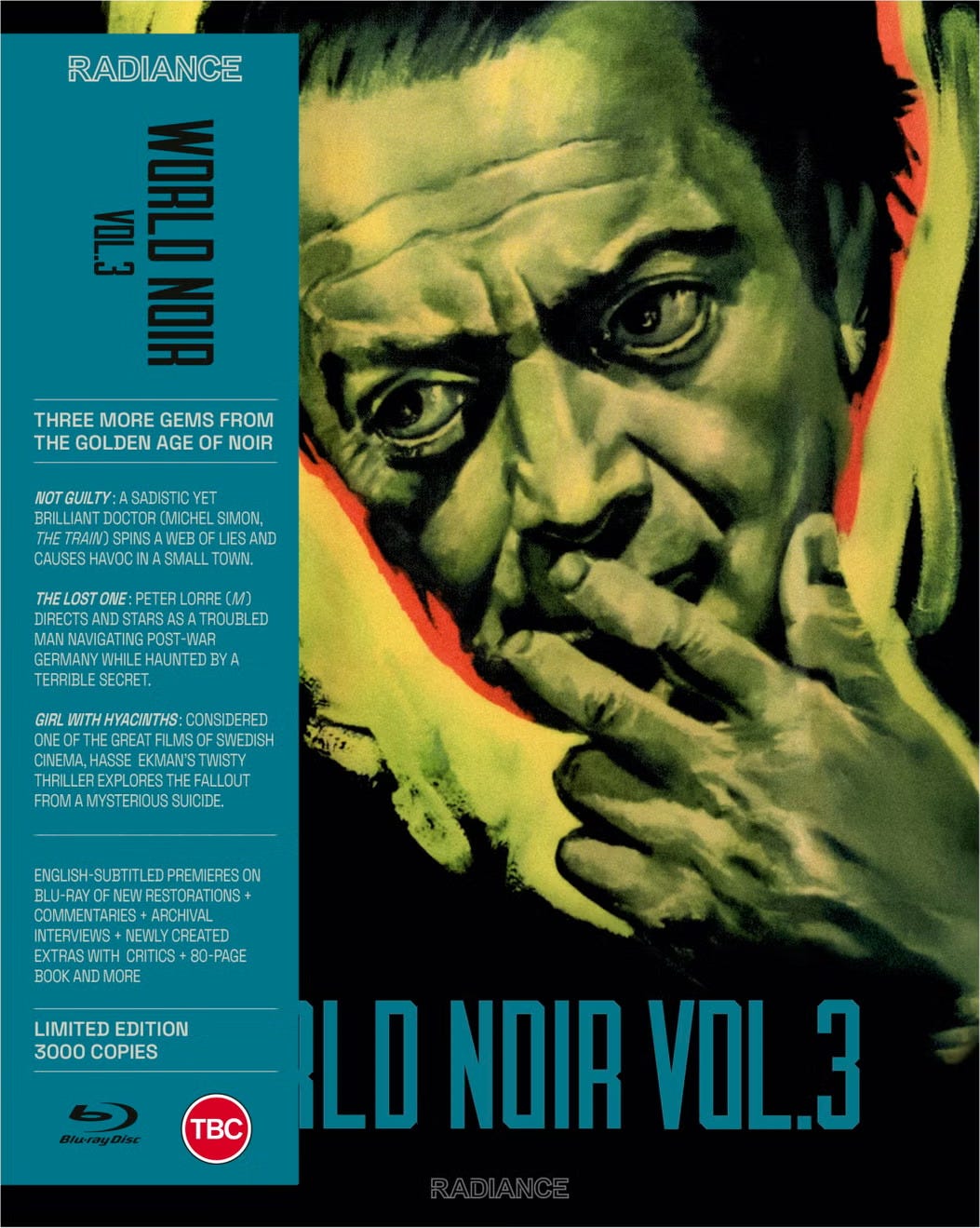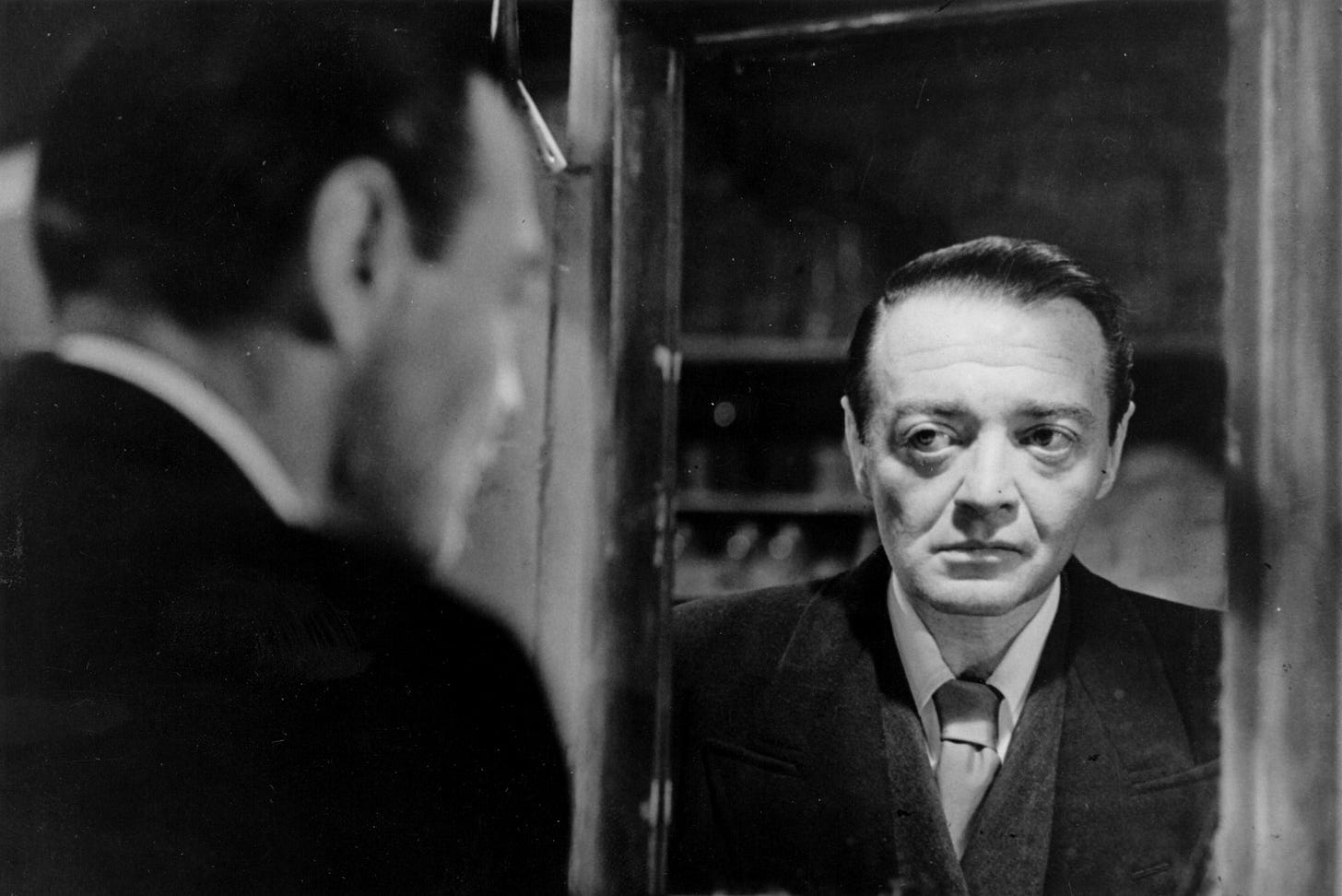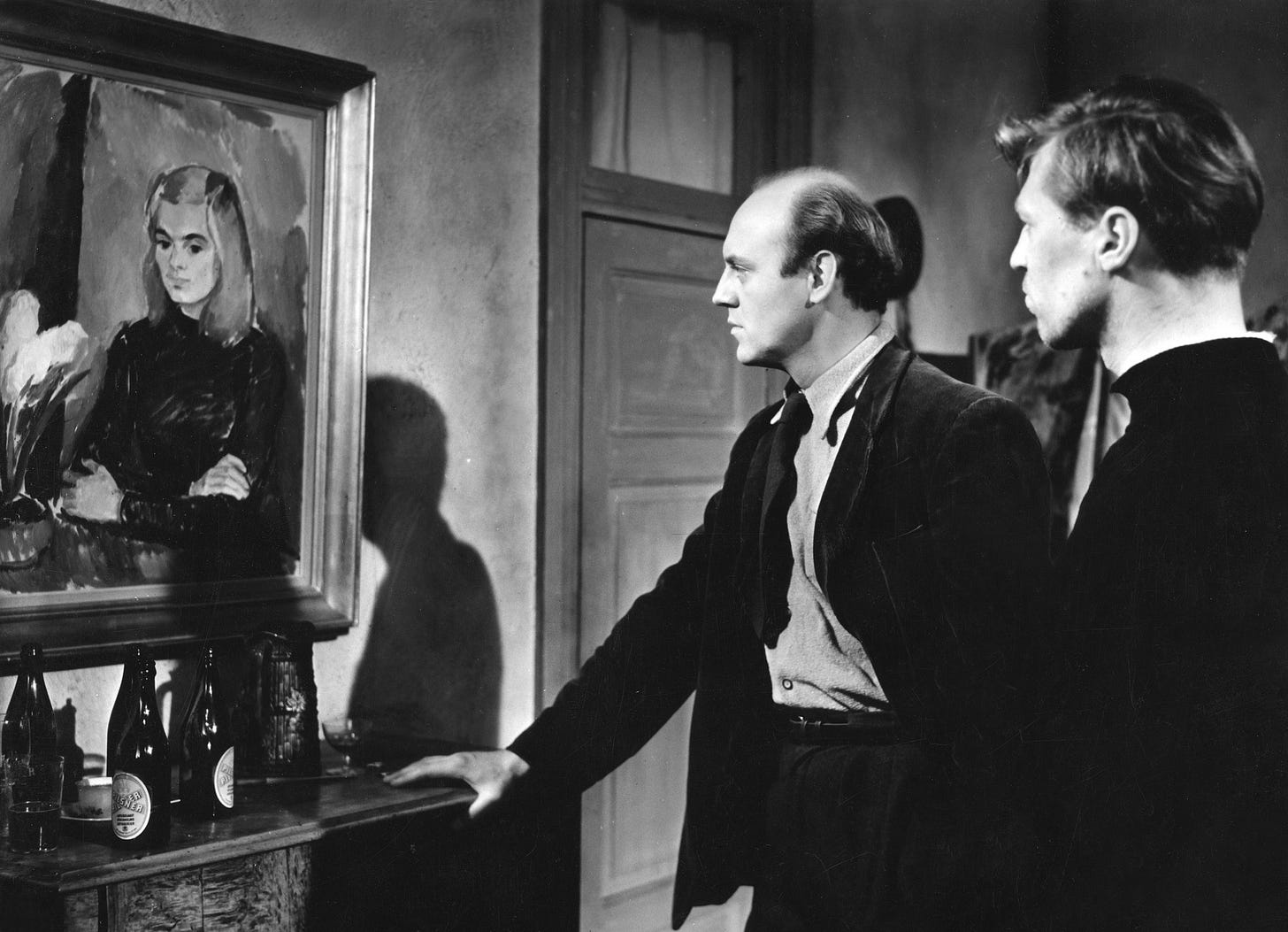World Noir Vol. 3, the latest box set from Radiance Films, proves that film noir was, and remains, a global phenomenon. With this collection the postwar era takes on various shades of darkness reflecting each film’s country of origin: France, Germany, and Sweden. Yet an overarching shadow unites these pictures through explorations of people in desperate situations. Since none of these movies were made in America, the absence of the Production Code ensures that you’ll experience no sugarcoating or tacked-on endings.1
Not Guilty (1947) Henri Decoin - France - 4K restoration, on Blu-ray for the first time with English subtitles
In a town near Paris, a woman named Madeleine (Jany Holt, right) wanders the streets at night, looking through the windows of open bars. Her gait suggests urgency and anxiety, but also familiarity. We sense that she knows what she’s going to find: her partner, the alcoholic Dr. Michel Anselin (Michel Simon, left) at some watering hole hitting the bottle. Madeleine’s suspicions prove true. Anselin is both in a bar and wasted, yet when she tells him he needs to come home, he acquiesces, but insists on driving.
In no time at all, Anselin’s inebriation causes him to lose control, hitting and killing a motorcyclist. Even intoxicated, the doctor is alert enough to cover up any evidence connecting him to the cyclist’s death. Yet afterward, something happens to Anselin. He keeps his eyes and ears attuned for any news of the death, wondering if he will be implicated. When that doesn’t happen, the doctor feels strangely compelled to help the police in their investigation, yet, because he’s the town drunk who has been abandoned by many of his patients, the authorities dismiss his entreaties.
What happens next is something we don’t often see in film noir: a man who is clearly guilty of a crime that no one recognizes as a crime. There’s an unmistakable, yet twisted, element of pride in Anselin, leading to frustration at the ineptness of the police in recognizing his guilt.
I won’t provide any more specifics, but let’s just say that Anselin isn’t finished with crime, not by a long shot. There’s more going on than a simple hunger for recognition from the local community. Something is happening that’s not always explored in film noir: the hunger for a different type of ambition that’s not tied to money, but pride.
Michel Simon is a force of nature in Not Guilty, and the ending (not the alternate one, also included on the disc) is perfect in its simplicity and power. The entire cast is wonderful, as is the cinematography of Jacques Lemare.
The Lost One (1951) Peter Lorre - Germany - HD digital transfer, on Blu-ray for the first time with English subtitles
Directed and cowritten by Peter Lorre, The Lost One was not a hit upon its release, particularly in Germany. Still smarting from the war, Germans understood far too well what Lorre was doing with the film and wanted no part of it. The picture wasn’t even screened in the U.S. until 1983 and has only recently been available on German and Spanish Blu-rays. Like Not Guilty, The Lost One is a dark journey, perhaps even darker than the Decoin film.
Lorre plays Dr. Karl Rothe, a physician working in a refugee camp who has been assigned a new assistant he doesn’t want, a man named Hösch (Karl John). Rothe has patients lined up inside and outside his medical tent, so the doctor’s dismissal of Hösch isn’t because he doesn’t need the help. As we learn through flashbacks, the two men have a troubled history.
Rothe and Hösch (both attempting to distance themselves from their pasts by not using their real names) previously worked for the Nazis during WWII. I won’t get into the details of their work and research, but Rothe learns that his fiancee Inge (Renate Mannhardt) has become a bit too interested in his projects and must be dealt with.
Themes of death and guilt soon become the focus of the plot, and while some have noted that Rothe gives audiences a look at what could’ve happened to Lorre’s character from M (1931) had he escaped, that’s not exactly what’s going on here. Yet, like M, scene after scene is filled with a similar style of German expressionism, city streets at night, and a somber feeling of dread that pervades the film and its people. The overall noirish mood contributes to the murkiness of the characters and the way Germany as a nation was trying to emerge from the aftermath of the war.
From the booklet included in the set, critic Lotte Eisner (1896-1983) is quoted regarding the belief that The Lost One would not be fully appreciated until years after its release: “Perhaps the case of Peter Lorre’s film is as complex as that of Limelight, which had to be seen and re-seen before all its layers of hidden beauty (could) be penetrated and some of its more bewildering aspects could be understood.”
While many cinephiles will no doubt purchase this set primarily for The Lost One, the real treasure from the collection is Girl with Hyacinths.
Girl with Hyacinths (1950) Hasse Ekman - Sweden - 2K restoration - on Blu-ray for the first time outside of Sweden
Part of me wants you to pay close attention to the opening of Girl with Hyacinths and another part simply wants you to lose yourself in the film. (Whatever you do, I urge you not to do any research on the movie, which could lead to a major spoiler.) A young woman plays piano at a bar, yet the music isn’t festive. A sense of sadness is firmly imprinted on her face, annoying at least one of the bar’s customers who engages in a brief exchange with the pianist. It’s not much of a spoiler to inform you that the somber young lady goes home and hangs herself. In the morning, no one in the neighborhood can understand why this woman, Dagmar Brink (Eva Henning), has committed suicide.
Yet the mysteries don’t end there. Dagmar has written a note stating that she’s leaving everything to her neighbors, Anders (Ulf Palme) and Britt Wilkner (Birgit Tengroth), a couple she barely knew. Anders takes this as a challenge (in a sort of Citizen Kane way) to discover what led Dagmar to take her own life.
Like reporter Jerry Thompson (William Alland) in Citizen Kane, Anders seeks to discover why Dagmar gave up on life by finding everyone who knew her, even if they don’t want to talk. With each encounter we learn more, but the information sometimes makes us feel that Anders (and we the audience) are running on a treadmill going nowhere.
Perhaps Dagmar’s secret lies in the books of poetry Anders finds in her apartment or the artist who painted her portrait? Maybe those who attended her funeral might provide some insight. Even better, maybe can he track down the three men he learns Dagmar was involved with during her brief life.
Henning loses herself in the role of Dagmar, a performance which, as the booklet points out, reminds viewers of Barbara Loden in Wanda (1970) or Kristen Dunst in Melancholia (2011). We wonder if the reason Anders can’t get a grip on who Dagmar was and why she gave up on life is due to people not really knowing her. But then again, maybe Dagmar did not wish to be known. Yet what is it about the world that led her to such a tragic end?
Everything about the film works: construction, pacing, performances, cinematography, you name it. Ingmar Bergman called the film “an absolute masterpiece.” After seeing Girl with Hyacinths, it’s hard to argue with him.
World Noir Vol.3 is a region-free set, and whether you purchase it directly from Radiance or a company such as DiabolikDVD, Deep Discount DVD, or another vendor, don’t wait around. This set, limited to 3,000 copies, could go out of print quickly. For those interested in the extras (which are excellent), I’ll refer you to the Radiance entry for the collection.
Thanks for reading. Stay tuned.
Yet, if you just can’t live without the Code, one film contains a “safe for American audiences” alternate ending as an extra.








Andy what are you doing to me??? I've already spent tons this month on the Criterion sale and now I gotta get this too?? Jeeeeeez.
I've wanted to see the Lore film ever since I read about it in an issue of Noir City.